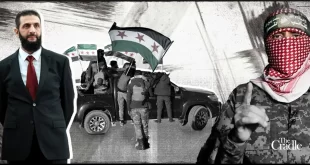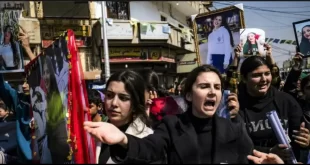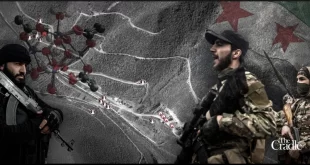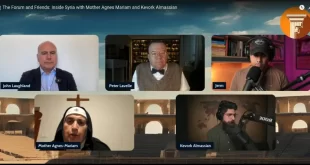The following article, by Peter Hitchens, is reposted from his blog at the Mail on Sunday:
The Show Trial of A and B.
Kafka comes to The Hague
Why you should be worried
You might think that when two honest men, with nothing to gain and much to lose, speak the truth about a major scandal in a body which might one day decide between world war and peace, that the world would immediately do the right thing.
You would be utterly wrong.
In the movies, the dissenters would quickly be recognised as the heroes of the story, their bosses would admit to doing wrong. The media would celebrate their courage. And the matter would be set right.
But the case of the Organisation for the Prohibition of Chemical Weapons (OPCW) shows that it would be foolish to expect that to happen. The OPCW is an agency of the UN. It exists to ensure impartial and rigorous inspection of the alleged use of chemical weapons. But it is now charged with being neither impartial nor rigorous.
An important story has been widely ignored, to the lasting shame of Western journalism. The organisation involved has made no move to correct the wrong. The individuals involved have been unfairly attacked by their own former employer.
Politicians have continued to repeat claims based on documents which have been gravely challenged, as if nothing had happened.
A summary of what happened
Fact: Leaks from the OPCW last summer, whose source has never been identified, showed that the OPCW had sidelined and suppressed key information undermining its own public conclusion that it was ‘reasonable’ to believe that chlorine gas had been used in warfare in Syria in April 2018.
A real expert
The leak cited work done by an OPCW inspector named Ian Henderson. Mr Henderson is a Chemical Engineer who studied at the universities of Witwatersrand and Durban and has considerable experience in ballistics thanks to military service as an artilleryman. He now lives in Australia. He is entirely non-political.
As we shall see, he has had long and distinguished service at the OPCW and was highly-regarded by them right up till the moment when he challenged attempts to exclude his work from consideration.
Unintentional
Fact: Asked about the Henderson disclosure, the OPCW stated that it was mounting a leak enquiry, so unintentionally confirming that the documents were genuine.
Not long afterwards, Mr Henderson was escorted from the OPCW building. This happened after he declined to take part in what he called a ‘witch-hunt’ against his colleagues. He has always said that he did not leak the material.
The second leak
Fact: Further evidence of wrongdoing emerged late last autumn, when another senior inspector at the OPCW identified himself to a panel of experts as ‘Alex’.
His testimony, reported by the website ‘Counterpunch, stated that the suppression of key information had gone much further. As confirmed by documents later published by Wikileaks, evidence which cast even more doubt on the chlorine gas verdict was filleted out of the reports eventually published by the OPCW.
Three mysterious Americans
‘Alex’ also recounted how astonishingly, a group of Americans had been introduced to the investigation team, and had more or less told them that chlorine had been used. Ian Henderson later confirmed that this wholly improper meeting had in fact taken place.
‘Make it sound like we found something’
At one point Mr Henderson had been told by a colleague: ‘we have been told by the first floor [the seat of power at the OPCW] that we have to make it sound like we found something’.
There had been serious internal rows in the OPCW about this censorship, fiercely over-ridden by senior officials. Inspectors had complained about being sidelined and having their work excluded from published reports. But they could get nowhere —as the OPCW has no agreed system in which would-be whistleblowers can access formal procedures. There was little the dissenters could do. But quite large numbers of OPCW staff must by then have been aware of the dissent.
In a statement which Ian Henderson addressed to the Security Council last January he makes claims that are quite astonishing. It describes his attempts to communicate his unease to the OPCW management.
“You will never get to the Director-General, and if you try and go around me to get to him, there will be consequences”
‘In the weeks following the incident, I attempted to redress the situation internally in a way that would not damage the credibility of the TS. This included the following: • I held discussions and meetings with the Chief of Cabinet, the (newly-joined) Director of Inspectorate, Head of Operations, Head of the Office of Confidentiality and Security, Director of the Office of Strategy and Policy, and the Acting Director of the Office of Internal Oversight. • I requested a meeting with the Director-General, as I thought the situation was serious enough to warrant him being made aware of it. The request for [a] meeting was denied and I was informed by a senior manager that “you will never get to the Director-General, and if you try and go around me to get to him, there will be consequences”. I shall identify the senior manager verbally, in his presence, should this be required. • I drafted a memorandum to the Director-General, through the Director of Inspectorate’.
Dossier
Henderson compiled a complete dossier of everything that was wrong with the Douma investigation. It was reviewed by the Chief of Cabinet but was not delivered to the DG. Henderson says, ‘I deposited a dossier with the Acting Director of the Office of Internal Oversight, together with a memorandum requesting an investigation by OIO into the situation of the FFM report. Months later I was informed that nothing would be done, as this was now seen as outside the scope of the activities of the Office of Internal Oversight.’
Slightly Foxed
By November 24th it was clear that the scandal was now out in the open.
Tucker Carlson, of Fox News, had interviewed Jonathan Steele about the revelations of ‘Alex’. The London Mail on Sunday carried the story prominently on Sunday 24th November, as did La Repubblica of Rome. Robert Fisk of ‘the Independent’ took up the case. Spectator America also covered it. The major news agencies made small references to it, one of which confirmed the authenticity of a crucial leaked e-mail.
The Sound of Silence
But most major media maintained an almost total silence about them. Meanwhile, on social media, sources sympathetic to the OPCW spread doubts about the validity of the leaks.
For weeks, the OPCW made no official response to these revelations.
Then, on 6th February the OPCW held a briefing for member states, in which it presented the outcome of its inquiry into the actions of two inspectors and an alleged breach of confidentiality. This was reported in a series of documents https://www.opcw.org/media-centre/news/2020/02/opcw-independent-investigation-possible-breaches-confidentiality-report
Who Shall Guard the Guardians?
One UK newspaper, ‘the Guardian’, reported this development thus:
The OPCW documents took the form of a show trial of both these individuals, conducted in their absence. Inspector A had said he would only participate in the investigation if the OPCW’s chief, Fernando Arias, was given a copy of his original complaint against what he saw as misuse of information. This was refused. Inspector B wished to bring his own lawyer. This also was refused. Both dissenters had tried repeatedly to take their concerns to Mr Arias, but they were blocked by senior management where the NATO powers which have been keen to intervene in Syria are well-represented.
Ad Hominem
The attack was almost entirely ad hominem, claiming, totally inaccurately, that they played a minor role, that they did not know the full story, that they had behaved in an underhand fashion. It did not in fact challenge the veracity of any of the leaks (for the simple reason that they are all true), but instead sought to belittle the two dissenters, who it referred to as ‘Inspector A’ and ‘Inspector B’.
Kafka Calls
These names make the whole thing sound like a mixture of Franz Kafka, Harold Pinter, J.B.Priestley and Inspector Morse. And Kafka, as so often, has provided the atmosphere of injustice, menace and obscurity.
But the claims made by the OPCW were shocking to those who actually know about the case. I am in a privileged position, I have spoken at length to Ian Henderson, who has been ‘outed’ beyond recall and who is obviously ‘Inspector A’. The identity of ‘Inspector B’ remains unrevealed.
I have since been in contact with both of them, receiving their detailed rebuttals to the charges made against them. It is my plan to publish these rebuttals in full at some point.
Telling the Security Council
But for the moment I will mainly refer readers to the written statement made by Ian Henderson to the UN Security Council. His ultimate employers, at a recent special session which discussed the case. He also made a briefer filmed statement. You may read the written document in full here:
https://thegrayzone.com/wp-content/uploads/2020/02/Henderson-Testimony-UN.pdf
Oh yes, he was: Inspector A was a member of the FFM
But first let us hear Inspector A’s response to the repeated claim that he was not a member of the OPCW FFM (Fact Finding Mission) which went to Douma in April 2018. Here is his own answer: The OPCW have claimed ‘Inspector A was not a member of the FFM, and his name is not included in the mandates issued for FFM deployments.
‘A: Wrong, and misleading. When the first team was assembled, Inspector A was on a mission in Nepal. Therefore, obviously, he couldn’t be on the mandate for the team first deploying. When he returned to HQ, it was agreed at the operational level that there was a need to add critical experience and expertise to the FFM. He was then notified to the Syrian Arab Republic as an addition to the FFM team and he joined them. Documents support this.’
This Doesn’t Quite Add Up
I might add to this that the Final Report of the FFM (Annex 6, para 11) says:
https://www.opcw.org/sites/default/files/documents/2019/03/s-1731-2019%28e%29.pdf
‘On 4 June, FFM team members tagged and sealed the cylinders from Locations 2 and 4, and documented the procedure.’
Now, there is no doubt that ‘Inspector A’ is Ian Henderson, whose name was on the leak which was investigated.
In his recent report to the UN Security Council he says :
‘I was the sub-team leader for the visit to “Site 8”, to further inspect and photograph the cylinders removed from Locations 2 and 4, and to apply tags/seals to them.’
This would seem to be a conflict. The OPCW’s own report says that FFM members tagged and sealed the cylinders. Mr Henderson was among those who did so and indeed led the team. In that case, surely, he must have been a member of the FFM.
Outstanding Professionals
This pretence that A and B are unimportant marginal figures is very odd. Both had in fact been considered outstanding professionals for the OPCW throughout their careers, and have many written notes commending the quality of their work. They were rehired – something the OPCW very rarely does – because the OPCW needed their experience.
The OPCW says they were rehired on a lower grade from the one they had previously held. It does not say that this was because the old higher grade had been abolished, and so it was no reflection on the two men’s skills and competence.
Underhand or Not?
THE OPCW also accuses Inspector A of underhand behaviour:
‘In July 2018, Inspector A, without proper authorisation, contacted companies about conducting an engineering
study on the cylinders found at two locations in Douma. When this became known to the team leader of the
FFM, Inspector A was instructed to refrain from making contact with any external third parties. The
investigation found that Inspector A did not accept this and decided that he was going to complete his study
alone—without informing the FFM team leader.’
Inspector A maintains that he behaved entirely properly and provided a detailed explanation of events in his statement to the UN Security Council (link above) beginning at paragraph 21.
Among many other attacks on the two inspectors is one which suggests that much of the investigation into the Douma incident was carried on after they had left or were no longer involved.
Only one visit to Douma
In fact there was only one OPCW visit to Douma and both A and B were deeply involved in it. Later work was done by an almost entirely different team, in what the OPCW calls ‘Country X’ which is almost certainly Turkey. No new information about chemical or ballistic or engineering matters was obtained on those deployments. And it was the suppression of important parts of the initial research, at Douma in April 2018, that caused the inspectors to dissent.
During this visit, Inspector A was in Douma, while Inspector B was in Damascus overseeing the technical and scientific operation. Inspector B *would* have been in Douma if his requests for the necessary security training (essential for such a risky deployment and very hard to complete at short notice) had not been turned down by the OPCW some time before. He was in close touch with the inspectors in Douma and was able to pass on his experience to them through secure communication. Inspector B is in fact one of only 4 inspectors (out of 10) who was present in Damascus for the entire duration of the investigation (14 April to 3 May). The team leader himself, who wrote the final report, left after 3 days, before the investigation ever began, which by an extension of the logic implied, invalidates the team leader’s contribution to the final report.
Inspector B was the planner and coordinator of all the scientific and technical activities on site. He was part of the sub-team involved in the negotiations with the Syrian authorities, participated in the interview process, wrote the on-site progress reports for the previous Director General, was the chief drafter of the original interim report, and with Inspector A, the most experienced inspector in the team. In fact, his 17 years’ experience as an inspector far outnumbers the average for the team.
Inspector B was the only organic chemist in the team and the recognised specialist in the OPCW when it came to chemical weapons production. As testimony to this, in his annual performance appraisals, it is cited by his supervisors that “he demonstrates a knowledge and skill in chemistry which is not possessed by others in the TS” (PMAS 2010), “I can say without fear of being unfair to others that you have been the professional in the TS that has contributed the most to the knowledge and understanding of CW chemistry applied to inspections. You produced a lot of knowledge and unselfishly shared every bit of what you know with others, enthusiastically” (PMAS 2017)’
There is more
I include these facts (a small sample of a 20,000 word dossier I have compiled on this matter) to indicate in just how many ways the OPCW’s attack on these two men is unfair and undeserved.
Perhaps even more important, the OPCW response does not in fact challenge their original concerns, which remain, about the investigation process and the report on Douma. These are that chemical, ballistics and engineering evidence from Douma itself, as well as evidence from external expert toxicologists, were known to the OPCW before the final report but suppressed by it because it would undermined its conclusion that said:
‘Regarding the alleged use of toxic chemicals as a weapon on 7 April 2018 in Douma, the Syrian Arab Republic, the evaluation and analysis of all the information gathered by the FFM—witnesses’ testimonies, environmental and biomedical samples analysis results, toxicological and ballistic analyses from experts, additional digital information from witnesses—provide reasonable grounds that the use of a toxic chemical as a weapon took place. This toxic chemical contained reactive chlorine. The toxic chemical was likely molecular chlorine.
A weak conclusion
Careful readers will note the weakness of the conclusion. ‘Reasonable grounds that the use of a toxic chemical took place’ is a very weak verdict. It is doubts that are usually reasonable. Grounds need to be demonstrable, as the burden of proof must lie with those who make the allegation, in any serious inquiry. As for ‘the toxic chemical was likely molecular chlorine’ this is also a remarkably weak and diffident statement, especially if it is being used to justify a large multinational military intervention (as it is).
It seems to me that the facts and expert opinions which the OPCW had suppressed in its published documents were, even so, unintentionally expressed in the weakness and vagueness of this conclusion.
 Syria Support Movement solidarity with the Syrian people
Syria Support Movement solidarity with the Syrian people




